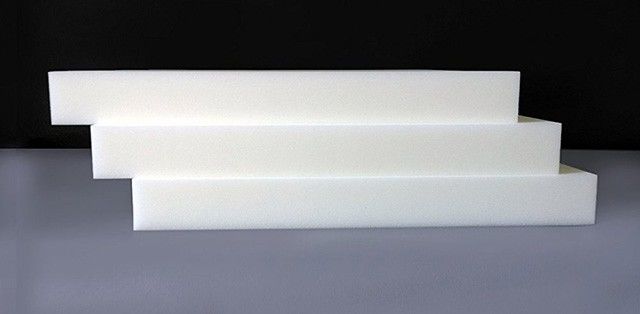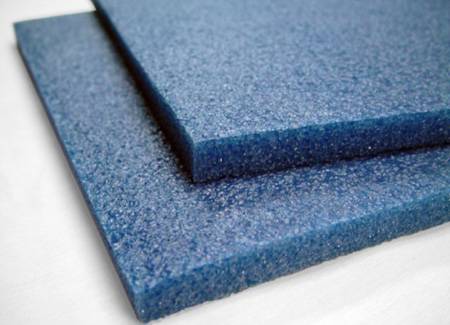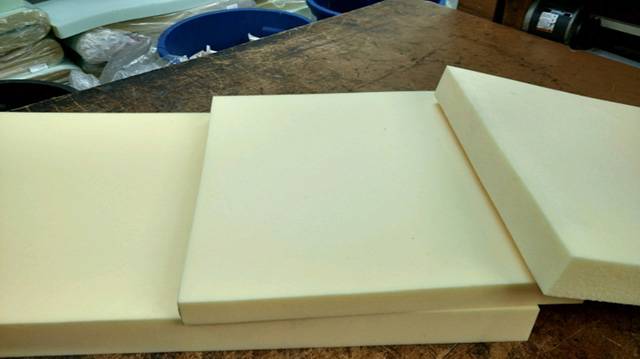As you shop for your next mattress, you’re going to come across a variety of material types. One that’s dominant in the industry is polyurethan foam. Also known as polyfoam or simply poly, this material is by far the most common you’ll come across in the comfort layer, and it’s utilized by nearly all major manufacturers. You’ll often find it on the top or bottom of the combined layer unit with foams of higher quality lying above or beneath. Since this material is relatively inexpensive to produce, it helps cut costs.
There’s a lot more science to mattress shopping than many realize. As a result, uninformed consumers get tricked into paying too much for sub-par products. Let’s make sure that’s not you. Keep reading to learn everything you need to know about this popular mattress material so you can shop wisely.
What is Polyfoam?
On the chemical level, polyurethane foam is very similar to memory foam. The difference is that polyfoam lacks the visco elastic properties that cause you to “sink” into the mattress. This means, with polyfoam, you can expect quicker bounce-back when releasing pressure. It’s also more resilient and able to more effectively support the heavier areas of the body like the hips and shoulders. Because of this quality, it can be used at the support layer as well as the comfort layer.
Three Standard Grades of Polyfoam
Polyfoam comes in three standard grades, and they’re gauged in terms of durability. There are a few things to keep in mind when it comes to these variations including:
- Lower grade has lower bounce back and durability.
- Softness or firmness does not indicate quality.
- Check the density of each polyfoam layer to ensure it’s high enough to indicate decent durability.
Let’s take a closer look at each of the three grades to give you a better understanding of how to spot them as you shop.
1. Lowest Grade- Conventional Polyfoam
Conventional polyfoam is what you’re likely to find when you run into a product that seems to be too cheap to be true. In this grade, you’re going to find densities less than 1.5 pcf. If you do consider conventional polyfoam, the key is to avoid products that feature its use in the comfort layer. This is where the majority of wear and tear takes place, so degradation will occur more rapidly.
It’s easy to get tricked into a low-grade mattress since polyfoam can be manufactured to feel very soft and comfortable upon first impression. It’s a very inexpensive way for some of the top national brands to make an easy buck as they put a mid to upper-range price tag on the product. Unless you’re in search of a temporary sleeping solution, conventional polyfoam in the comfort layer will begin to develop depressions more quickly than most other materials.
At the very lowest budget levels, you’ll likely run across ILD’s as low as 1.2 pcf. If this is the case for anything you’re seriously considering, make sure the layer used is no more than an inch in thickness.
2. High Density (HD) Polyfoam
We now move up the ladder to high density, also known as HD, polyfoam. This material features a density of between 1.5 and 1.7 pcf. Since it can be difficult to produce soft polyfoam in layers with higher densities than this, it’s typical to see HD polyfoam used in the comfort layer. Just some of the advantages you get to enjoy over conventional foam include:
- Longer-lasting
- Can be used effectively in smaller 1-2 inch layers or in tandem with firmer foams
- Can be a good choice in the comfort layer in its firmer versions and still feature a low price
If you find HD polyfoam layers in a product you’re considering on the lower end of the density scale (1.5 pcf), definitely note how thick the layer is. You want to ensure it’s either small or the mattress is able to be flipped so you can spread out the durability timeframe on more than one surface.
3. High Resiliency (HR) Polyfoam
High resiliency polyfoam is the highest quality you’ll find on the market, and it features densities between 1.8 and 2.5 pcf. There are a number of unique qualities that set HR polyfoam apart from its two lower-grade relatives including:
- Foam has a support factor of at least 2.4
- Foam uses a different chemical formula with its own unique cell structure
- More durable in all ILDs from very plush to very firm
- Suitable without exception in both comfort and support layers
- Good durability expectations
Keys for Shopping Polyfoam in the Comfort Layer
If you see polyfoam included in the comfort layer of a mattress you’re considering, red flags should pop up. While you could find a great product with reasonable durability expectations, you’re typically doing yourself a favor by assuming the material is low-grade. To find out for sure, make sure you consider the following tips for discovering otherwise:
- Inquire about the densities of the polyfoam. Companies that are very transparent and cooperative in providing this information often don’t have anything to hide.
- Make sure you avoid any more than 1 inch in lower-grade polyfoam layers.
- Minimize the use of polyfoam in the comfort layers unless you’re able to verify that the foam is HR or, when properly constructed and at the right price, HD grade.
Polyfoam in the Support Layer
Polyfoam can often be more reasonably used in the support layer of your mattress. Since the comfort layers absorb most of the pressure you put on your mattress every night, they are typically slower to degrade. If you’re considering a product that features polyfoam in the lower levels of the unit, there are different guidelines to follow to ensure you find one that will give you the most for your money.
— Conventional Polyfoam Support
Again, conventional polyfoam is the lowest grade. Ideally, you don’t want it in any level of your mattresses construction. If you do find one you’re interested, you want to make sure the layer is no more than one-inch thick. Unless the mattress will only be used for a short period of time, conventional polyfoam in the support layer should be avoided all together. Aside from the fact that they lack the qualities you want to look for in a strong support base, they will also break down quickly with regular use.
— High Density (HD) Support Polyfoam
High density polyfoam is often difficult to find in plusher options, and its firmer versions are a popular choice in the support layer. This material can provide the comfort and support you’re looking for when used with memory foam or other soft foams. Since it has a higher durability expectation, it will last longer than conventional polyfoam more effectively and maintain its firmness level. However, if you’re strongly focused on durability, you’ll find a higher degree in innerspring, latex, and HR polyfoams. These materials are known to offer a higher degree of resilience and progressive resistance.
High-density polyfoam is relatively inexpensive to manufacture. However, you’ll often find products priced in the mid to high-range that feature its use. In these cases, you typically find high-quality materials like latex used above it. The key to keep in mind is that the weakest link of your mattress is the comfort layer. Therefore, if you find a product with high-quality comfort layers combined with a HD polyfoam base, you should be pretty happy when it comes to durability. If you’re not sure of the quality of the polyfoam of a product you may be considering, it’s usually safe to assume that it’s HD polyfoam. If the price reflects otherwise, you should take the time to contact customer support to inquire further.
— High Resiliency (HR) Polyfoam Support
High resiliency polyfoam features the chemical combination that makes it different than the lower grades, and this increases durability. It’s able to be made very soft, very firm, and anywhere in between, making it ideal for anywhere in your mattress.
You’re not likely to run across HR polyfoams as they’re much more expensive to produce. However, if you do run into its use in the support layer, it’s typically able to hold up as well as latex and innerspring materials under similar stress.
Handy tip: HR polyfoam is less expensive than latex and more expensive than innerspring, generally speaking. Prices should be reflective of this.
How to Shop Wisely
You get what you pay for, and polyfoam is known for being inexpensive. However, you want to make sure you’re not sacrificing when it comes to quality. In the case of polyfoam, it’s just as well that you do shop online and not be deceived when you lay on a product in the showroom that feels great upon first impression only to disappoint later on down the road. This is just one of the many tricks of the trade to increase profits at the expense of decreased durability and customer satisfaction.
As you shop, keep in mind that, while in small layers polyfoam can offer comfort, you want to avoid products that feature very thick or frequent layers. This material can make a big difference in price, but it’s the weakest link in the product and will begin to degrade more quickly. They are also prone to the development of sagging, and it’s not uncommon to hear of impressions up to two inches deep in a short period of time. This development is normal in natural products, but it’s a sign of distress when it comes to foam. As soon as sagging becomes apparent, you’ll know that the components that provide comfort and pressure relief are degrading, and you’ll soon need to replace your mattress.
If you’re currently using a product that contains polyfoam along with other materials of higher quality, it’s likely that the polyfoam is the source of your troubles. Don’t fall into the common trap of blaming the problem on the other materials and buy another mattress of low quality and durability.
Be Cautious of False Claims
You get what you pay for, and polyfoam is known for being inexpensive. However, you want to make sure you’re not sacrificing when it comes to quality. In the case of polyfoam, it’s just as well that you do shop online and not be deceived when you lay on a product in the showroom that feels great upon first impression only to disappoint later on down the road. This is just one of the many tricks of the trade to increase profits at the expense of decreased durability and customer satisfaction.
As you shop polyfoam products, it’s important to remain cautious and aware of the many false claims being made in the industry. HR polyfoam is very often mislabeled. For example, it’s common to call any polyfoam with a density over 2.5 pcf or lower HR polyfoam. What you’re often not told, however, is that it doesn’t have the necessary support factor of 2.4 or more.
You’d be surprised at how little many mattress salesmen actually know about the details of these classifications, and it’s not uncommon to come across merchants who aren’t really sure what you mean when you use terms like “support factor” or “comfort factor”. Sometimes this is due to ignorance, but it’s also often hidden when they know their materials are subpar. When you do find a true HD grade polyfoam, it’ll feature:
- Great resilience
- Excellent durability
- Comparable feel to latex
Is a Mattress Containing Polyfoam Right for You?
As with most things in life, there are pros and cons when it comes to polyfoam. It’s lower-grade form can offer a reasonable temporary sleep solution. However, when seeking a long-term mattress, it pays to understand the various grades of polyfoam out there and how to spot a good usage of the material. In a nutshell:
- Lower-grade polyfoams can be appropriate when higher-quality materials are used in the comfort layers.
- High-grade polyfoam offers a slightly less expensive option for those impressed with latex as a support layer.
I hope you learned a thing or two using this polyurethane foam guide as you shop for your next mattress. You spend around 33 percent of your life in your bed, so it’s more important than some people give it credit for to spend the time necessary to understand what you’re investing in.






